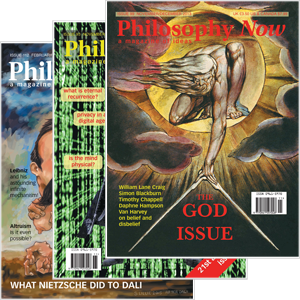
Your complimentary articles
You’ve read two of your four complimentary articles for this month.
You can read four articles free per month. To have complete access to the thousands of philosophy articles on this site, please
Books
Irreducible by Federico Faggin
Frank S. Robinson doubts a holistic vision of life, the universe, and everything.
Federico Faggin is one of the major pioneers of computing. Among other breakthroughs, in 1971 he invented the first commercial microprocessor, laying the groundwork for modern information technology. In Irreducible: Consciousness, Life, Computers, and Human Nature (2024) he propounds a startling theory of consciousness. Before we get to that though, the book extensively discusses classical physics versus quantum mechanics.
We know that something seemingly solid, like a hammer, is made of atoms that are mostly empty space. We might mistakenly picture a miniature solar system, with electrons orbiting the nucleus. But not even the subatomic particles are solid. They’re not tiny balls; it’s a special kind of wispiness all the way down.
Faggin stresses quantum uncertainty and indeterminacy. Prior to experimental measurement, the best we can do is delineate a probability of an electron, say, being in a certain place. Or we might say that quantum wave-particles, whatever they are, exist in spacetime. Yet even that’s problematic. Again, drilling down to the quantum level, not even space seems to have the characteristics we commonly conceptualize for it.
All this leads Faggin to posit that the reality we think we inhabit isn’t actually there after all, at least not in the way we envision it (which he also considers wrongly materialistic and reductionist). Another view, however, is that quantum physics describes a submicroscopic reality operating very differently from the realm of classical physics; yet everyday reality is not some sort of misleading mirage, but rather, the two levels work separately. Even under quantum mechanics, a hammer still pounds nails. Isn’t that an aspect of reality?
Anyhow, Faggin’s take on reality is integral to his theory of consciousness – which does require breaking from our common understanding of reality.

Irreducible by Cecilia Mou
© Cecilia Mou 2025 Instagram @moucecilia
From Emptiness to Being Full
To get there, let’s start with the book’s introduction, which relates how Faggin’s material success left him feeling existentially empty.
This mid-life crisis centered upon his inability to understand qualia, an important concept in discussions of consciousness. A quale is a subjective experience. But whence comes the ‘you’ doing all this experiencing? That’s the question at the heart of this book.
Faggin relates an unusual subjective experience of his own. One night he had an ‘awakening’: he “suddenly felt a powerful rush of energy” which he “could not even imagine possible… a love so intense and so incredibly fulfilling”. He experienced it “as a broad beam of shimmering white light, alive and beatific, gushing from [his] heart with incredible strength. Then suddenly that light exploded. It expanded to embrace the entire universe.” This convinced him “that this was the substance out of which everything that exists is made… what created the universe out of itself” (p.10).
Most surprising however, was its source: himself. Or as he puts it, “Then… I recognized that I was that light”. Well, Faggin presumably had an experience – a quale – which must have been generated by his neurons with no outside stimulus. I’m guessing no one else in that room would have seen the bright light (I’m reminded of a family member insisting she’d experienced time going backward). Faggin himself tellingly says, “I was both the experiencer and the experience.”
Anyhow, whatever happened there, it led to his philosophical epiphany: “everything is ‘made of’ love… I had experienced the existence of another dimension of reality… impossible to comprehend with ordinary logic.” And finally the big reveal: “the only possible way to explain how the universe can create life and consciousness is that the universe is itself alive and conscious from the outset.” It has “had free will forever”.
This is no scientific construct; and is assuredly not the only possible way to explain life. While science has not nailed down every nuance, scientists like Darwin and Dawkins have done a much better job of explaining it. And what about ‘another dimension of reality’? That abuses the word ‘dimension’, as Faggin is not talking about a ‘dimension’ in any scientific sense. Then there is the word ‘love’ – so much over-used that it can become devoid of meaning. Anyone saying “everything is ‘made of’ love” as Faggin does, has no idea what they’re talking about.
Consciousness Not Explained
Likening the conscious mind to a computer does provide some helpful insight, but only gets us so far, and may be how Faggin has gone so far astray. He writes, “I could not find any way to convert the electrical signals of the computer into qualia, because qualia belong to a different kind of reality with no apparent connection to symbols” (p.9). ‘Symbols’ is another crucial word for Faggin. We only understand anything through symbolification, as that’s precisely what language does. Thus your rational mind works by deciphering symbols into concepts. But the ‘you’ here is again the problem: how you turn symbols and qualia into something you somehow understand. It’s not that qualia have ‘no apparent connection to symbols’; it’s that they have no apparent connection to anything constituting you.
To solve this puzzle, the best modern science can do is to posit that the ‘you’ experiencing consciousness (including, but not limited to, qualia) must emerge from neuronal functioning. While we don’t (yet) know how, this provides at least a potential basis for an explanation. This approach is one that Faggin contemptuously rejects, deeming it impossible that consciousness could emerge from elements themselves lacking it, such as merely physical brain activity. He argues that consciousness must be an irreducible property of nature already present in the primordial stuff from which space, time, energy, and matter emerged. Thus every cell in our bodies must be conscious, as indeed must everything that exists: “a grain of sand, a stone, a plant.”
The common term for what he’s putting forward here is panpsychism, an idea that, as he says, has a long history — indeed, originating in animism, back when humans understood little of nature. But even though we don’t know how consciousness emerges from brain processing, it makes sense that it must – whereas how panpsychism could be true has no explanation, and is an even bigger speculative leap. Faggin himself uses the word ‘seity’ (a jargon word for selfhood) to signify a phenomenon that somehow operates inside a person as the source of what’s experienced as consciousness, as an alternative to consciousness arising by itself out of the body’s physical functioning.
The same logical black hole swallows Faggin’s notion of a universe ‘alive and conscious from the outset’: he offers no theory for how his panpsychic ‘seities’ could have existed in the first place. Moreover, there is no evidence whatsoever for the universe itself having some sort of consciousness. If it is conscious, it has hidden that quite cleverly. Why would it?
In sum, Ockham’s Razor [‘simpler is better’, Ed] favors what conventional science says over Faggin’s theory, which is complete nonsense.
© Frank S. Robinson 2025
Frank S. Robinson is the author of eight books, including The Case for Rational Optimism. He blogs at rationaloptimist.wordpress.com.
• Irreducible: Consciousness, Life, Computers, and Human Nature, Frederico Faggin, 2024, Essentia, £14.55 pb, 336 pages









